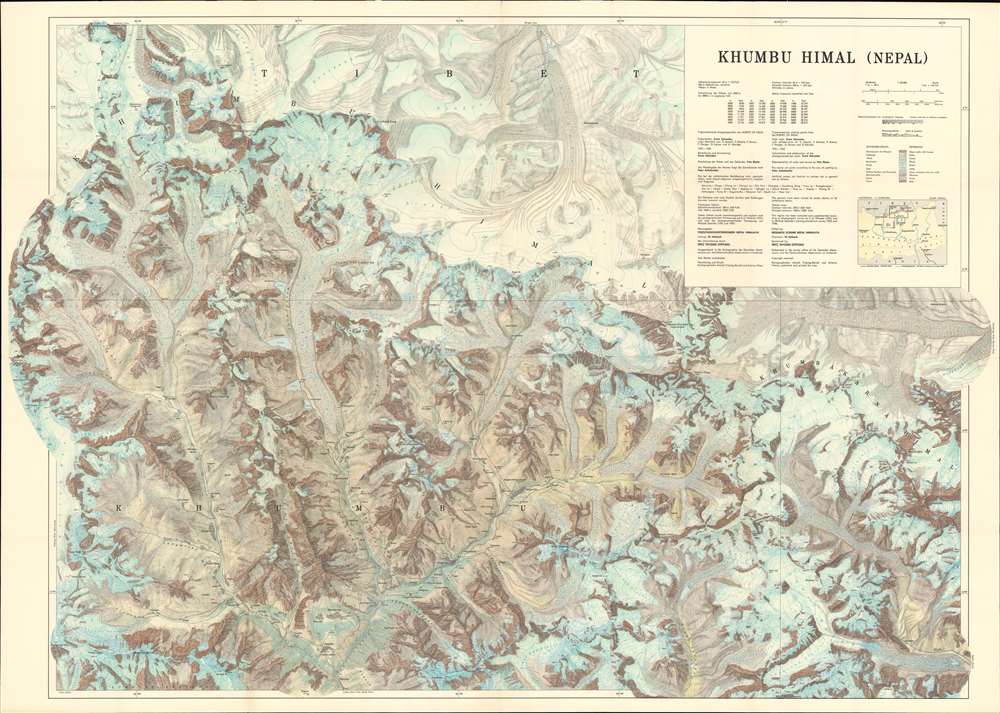This item has been sold, but you can get on the Waitlist to be notified if another example becomes available.
1965 Research Scheme Nepal Himalaya Map of Mount Everest and the Himalayas
KhumbuHimalEverest-hellmich-1965
Title
1965 (dated) 34.75 x 49 in (88.265 x 124.46 cm) 1 : 50000
Description
Erwin Schneider and Fritz Ebster
This map is a result of a terrestrial photogrammetric survey of the Everest region completed in 1955 by Erwin Schneider. Schneider's work has been called a 'masterpiece of reconnaissance surveying'. The photogrammetric equipment weighted over 50lbs and getting to the photogrammetric stations often required intense technical assents, underscoring Schneider's remarkable fortitude as a climber.Over the course of some five months of intensive work, Schneider's field sketches and diagrams were turned into relief-like illustrations of bedrock, moraines, glaciers, and more by Austrian cartographic draftsman Fritz Ebster (1901 - 1979). Stylistically it follows in the model of the Österreichischer Alpenverein (Austrian Mountaineering Club) maps, with which Ebster would have been most familiar.
Terrestrial Photogrammetry
Terrestrial Photogrammetry is the science of determining geographical positions and making maps from photographs taken from high-altitude vantage points. It was developed in the mid-19th century with the invention of photography. The essential premise is that the distance between two points that lie on a plane parallel to the photographic image's plane can be determined by measuring their distance in an image, presuming that the scale of the image is known. The techniques were highly refined during World War II and following the war, more scientific uses for the system were embraced - as here.Publication History and Census
This map was compiled from fieldwork executed by Erwin Schneider and with trigonometric starting points provided by the Survey of India. The whole was edited by Research Scheme Nepal Himalaya (Forschungsunternehmen Nepal Himalaya) and was published and printed by Kartographische Anstalt Freytag-Berndt und Artaria. Three editions were published. The first, of which the present copy is an example, appeared in 1965. The second was published in 1978 and was followed by the third edition in 1985. All appear in institutional collections but are scarce on the private market.Cartographer
Erwin Hermann Manfred Schneider (April 13, 1906 - August 18, 1987) was an Austrian cartographer and mountaineer active in the middle part of the 20th century. Schneider was born in Jáchymov, a Bohemian mining town on the German-Czech border. He initially studied in Idira (Idrija), Slovenia before moving on to higher studies in Salzburg. He enrolled in the Technical University of Charlottenburg in Berlin, Germany, from 1924 - 1935, where he studied mining. Schneider was a very active professional mountain climber, ascending some 5 of the 11 seven-thousand meter peaks, earning him the nickname, 'Seven-Thousand King.' He was a member of the Association for Comparative High Mountain Research (Arbeitsgemeinschaft für vergleichende Hochgebirgsforschung) and official cartographer of the German Alpine Association (Deutscher Alpenverein). Schneider was the lead cartographer on the important Norman G. Dyrhenfurth Himalaya Expedition of 1955 which produced the first and most important modern survey of the Nepalese approaches to Mount Everest, published in 1957. His corpus also includes a series of important mountaineering maps of Nepal that are generally known as the 'Schneider Maps'. More by this mapmaker...

